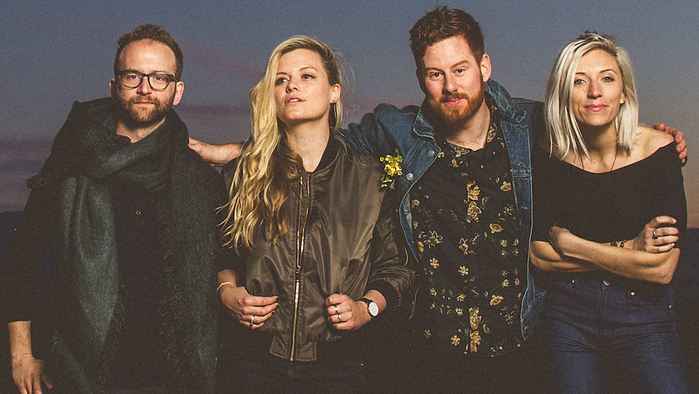This post is contributed by guest blogger Michael Leibovich who shares his thoughts on medium.com. Here is an excerpt from his well-written article How My Band and 5 Others Raised Over $500,000 on Kickstarter which has several salient points beyond the tips he shares here. Take it away, Michael!
Interesting factoid for people considering crowdfunding: over $2.3 million dollars was pledged through Kickstarter’s platform in April 2016 alone. That’s almost twice what was pledged in April 2015!
So how is it that even as more money is being raised that ever, only 36% of projects reach their goal according to Kickstarter? Even more importantly to you, what factors determine whether your campaign will succeed or fail?
Here are the most critical factors from running my band’s successful Kickstarter campaign. And for even more tips, read the Do’s and Dont’s from 5 other wildly successful Kickstarter artists who raised a total of over $500,000!

Fialta: $18,554 raised | 309% to goal
CRAFTING YOUR STORY
Do: Let people connect with you, your passion, your challenges, etc. Make them feel something and believe in you. Focus on emotionally connecting with people first and foremost.
Take the time to explain your story in both your video and your campaign landing page. People have different learning styles, so make sure you cater to them with video, images, and text. Write out a script for your video and structure it to contain the Why first, the What second, and the How third.
Don’t: Try to convince people how awesome you are and how amazing your sh*t is.
(Note from Ian: I call this “bullshit hype”.)
Show them authenticity.
CREATING REWARDS
Do: Make a spreadsheet with all your rewards, costs of goods, and cost of delivery. Look to create rewards that are unique AND have high margins (60% or more). If you aren’t savvy with numbers, find someone who is. Don’t skip this step.
Don’t: Add stretch goals that end up losing you money. After we hit our first stretch goal, we were really anxious to add vinyl. But after pricing it out, it was actually going to take a huge financial commitment to add it as a reward. We opted instead for delivering our album earlier than promised.
GATHERING FEEDBACK
Do: Make a list of 30 close friends and family and individually email them with a link to your unpublished project. During the pre-launch feedback phase, we ended up re-editing our video, changing half-a-dozen reward tiers, and updating several structural elements of our campaign.
Don’t: Spam your family and friends. Your communications should be as personal as possible. Yes, it will take you much longer to contact and connect with people, but that’s part of the deal. Embrace it.
(Note from Ian: this is part of the crucial Pre-load process which you can learn exactly how to do from our free mini-course by [thrive_2step id=’8586′]clicking here[/thrive_2step]. This also applies to Michael’s next point.)
PREPPING FOR LAUNCH
Do: Soft launch a day early and ask your closest circle of friends and family to pledge in the first 24 hours. By the next day, when you announce you are live, you will already have some momentum going, which makes it that much easier for those on the fence to get involved.
Don’t: Focus on showing versus telling. Social proof is the most powerful advertisement of all. If your soft launch does what it is supposed to do, you’ll spend your first day talking about how far along you are already are, which will get people that much more excited to participate. People want to bet on a winner. Give them ammo.
FOLLOWING UP WITH BACKERS
Do: We sent personal video thank you messages to all backers that pledged within the first two days. Be grateful, be appreciative, be sincere, and take the extra time to show how much the support means to you.
Don’t: Give too many updates. Your backers want to be involved and know how things are progressing, but they’ve already pledged. Unless you’re giving them exclusive content or asking for something specific (and important), keep your updates to one/week.
GENERATING PUBLICITY
Do: Consider investing in Facebook advertising. Over 40% of our pledges came from Facebook. We experimented with boosting posts and even some targeted ads. Start with a small budget, and add to it incrementally after you get a direct conversion. Contact local radio and ask to play a few songs on-air while your campaign is active. Kickstarter is about community and your local community will want to participate.
(Note from Ian: just to be clear, remember that your #1 priority during the campaign is to reach your current fans, friends and family. The best way to do that is with personal outreach. Facebook advertising is an option if you are having trouble reaching the fans you already have on Facebook. This is more likely to happen to bands/artists with larger followings. But if you don’t know how to do it or it will take you a lot of time or you are just starting out and your Facebook audience is under 1,000 people, then keep in mind that this is a lower tier priority than personal outreach.)
Don’t: As soon as you launch, you’ll be inundated with offers from companies that scour the list of new projects offering PR services. Ignore them. Don’t waste too much time chasing traditional press. Unless your project is truly newsworthy, you will likely be chasing a dead-end. Instead, focus on your fans, your email list, your social networks, and local radio and newspapers.
Want more tips? Check out my interviews with 5 artists who collectively raised over $500,000 on Kickstarter.
Leave a Reply